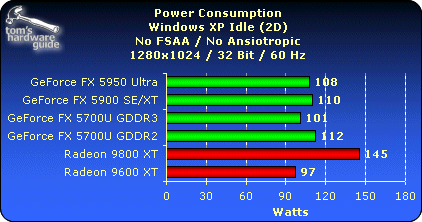GDDR-3 Memory: GeForce FX 5700 Ultra
Power Consumption

In response to a suggestion from several of our readers, we will include measurements of the cards' power consumption from now on. In order to do this, we use a simple measuring device (Conrad Elektronik Energy-Check 3000) which shows us the overall power draw of the entire test system. Since most modern graphics feature their own 5V or 12V power plugs, measuring their power draw on the AGP port only wouldn't be very helpful. So while we can't give you exact numbers for the power requirements of each card, you'll be able to determine their needs by comparing the results.
We test each card in three different modes of operation. First we determine how much power a card requires during the power-on cycle of the computer, before the OS begins loading. The second measurement occurs after the OS has finished loading, with the card idling in 2D mode. The last measurement is taken in 3D mode, for which we used the benchmark Aquamark3, as it turns out to be the most power-hungry 3D application we've found yet.
To let you place the power draw of our candidates in context, we also included an ATi Radeon 9800XT and an NVIDIA GeForce FX5950 Ultra in this test.

The Radeon 9600XT proves to be the least demanding of the cards, closely followed by the GDDR-3 version of the FX 5700 Ultra. The GDDR-2 version of the same card draws noticeably more power. ATi's Radeon 9800XT takes top spot here, requiring the most power.

At this point, the OS has finished loading. The drivers tend to lower the clockspeed here in idle mode, reducing the cards' power draw. Nonetheless, the difference between the two FX 5700 variants is still quite pronounced. Once again, the Radeon 9600XT is the most frugal, while its big brother, the 9800XT, is the most power hungry.

Even in games, the Radeon 9600XT is the most economical. The FX 5700 Ultras both use significantly more power. This time, however, the top spot goes to the GeForce FX 5950 Ultra, with the Radeon 9800XT nipping at its heels.
Stay on the Cutting Edge
Join the experts who read Tom's Hardware for the inside track on enthusiast PC tech news — and have for over 25 years. We'll send breaking news and in-depth reviews of CPUs, GPUs, AI, maker hardware and more straight to your inbox.
Most Popular

